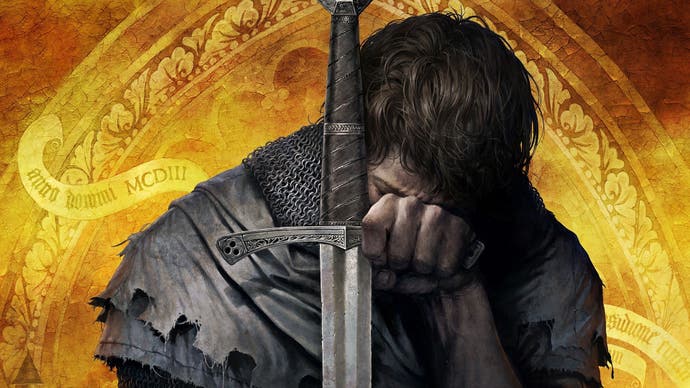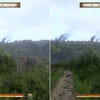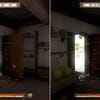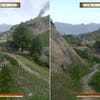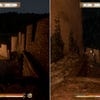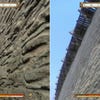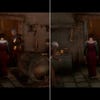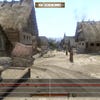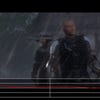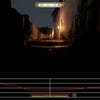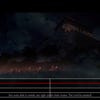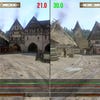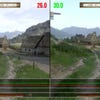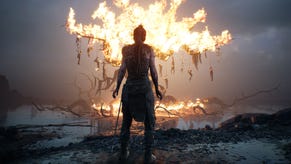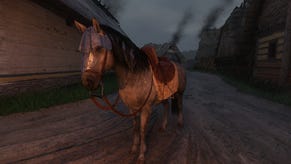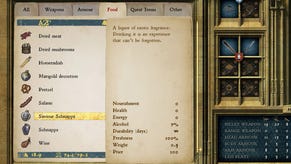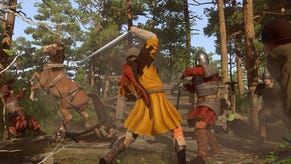Kingdom Come: Deliverance is one of the most ambitious Switch ports we've seen
The compromises are obvious - but the end result is still impressive.
Kingdom Come: Deliverance joins an impressive list of 'impossible ports' on Nintendo Switch and ranks among the most ambitious yet seen on the system. Originally developed by Warhorse Studios for PlayStation 4, Xbox One and PC back in 2018, it's an open world fantasy RPG powered by CryEngine 3. Marked by sprawling landscapes, complex towns - plus the more advanced CryEngine features for its time, it truly pushed last-gen consoles to their limits. And still does, in fact, given that performance struggles to always lock at 30fps to this day. So today, the challenge of making a such a game run on Switch - a portable machine with greater hardware limits - isn't a trivial one.
Rising to that challenge is Saber Interactive, a team that - on paper - is more than qualified for the task. Between its work on the Switch ports for the Crysis Trilogy and The Witcher 3, the studio not only has close experience with CryEngine on its CV, but also in leveraging the power of Nintendo's system to handle richly detailed open world RPGs. Let's be honest though: you likely know how this is going to turn out. Switch's 2017 mobile technology is showing its age, and we're long overdue a successor. In cases like Kingdom Come: Deliverance - or Crysis, or The Witcher 3 - the expertise of the developer handling the port only goes so far. When facing strict hardware limits as we have on Switch, a balance must be struck between performance and visual features, and we have to accept it for what it is - but the fact we have the game at all on Switch, I think, is something to be celebrated. And to be frank, there are some nice surprises.
Kicking off, the loading times are a surprise win on Switch. Stacked up against the existing Xbox One version, measuring the time it takes to get from each system's front-end menu to the game's title screen throws up something intriguing: Saber has managed to accelerate these transitions on Switch - and notably the speed of booting game. We get an 86 second wait to get to the game's title screen on Switch, for example, which is hardly a snappy turnaround, but this still compares favourably to Xbox One at 157 seconds. The bandwidth to its internal SD card storage is no doubt a huge help. The install footprint of the game is potentially reduced on Switch as well - in texture and audio asset quality - which means less data to load in overall. Either way, first impressions are positive.
Looking at the visuals, Kingdom Come: Deliverance on Switch doesn't skimp on CryEngine features either. Stacked up against Xbox One - a much more capable machine - both run Kingdom Come with a 30fps target, and unlike the launch build in 2018, both current versions fix the 31fps cap issue to give a more expected 30fps line today. In terms of resolutions, the Switch has a similar setup to the Crysis Trilogy Saber worked on. We get a 720p target while docked, dynamically dropping 540p when the GPU is stressed. Temporal upscaling is used to help reconstruct the image, and it does so effectively.
Certainly, image clarity struggles to match up to the typical 900p reading on an Xbox One - or PS4 for that matter. It's softer: facial expressions lose definition in the upscale, as does finer detail across a landscape. But it still looks respectable given the caliber of the hardware, and is better enjoyed on Switch's own display in portable mode. One final point: a form of sharpening is used on the Switch image at points. On grassy elements, or the silhouette of distant trees, the frame is over-sharpened at times in broad daylight which isn't flattering to the low base resolution. (Update 16/03/24: a clarirication here - the sharpening is a deliberate effect that kicks in any time the 'drunk' status icon appears). Beyond that, this is about as good as you might expect from the hardware in terms of pixels being pushed, and if nothing else, it's serviceable for a portable experience.
Sticking to the positives, the Switch release packs in as many CryEngine features as possible. There's full use of SSR - screen-space reflections - across large water bodies, plus water simulation. Honestly, SSR could so easily have been removed in the process of optimising for a 30fps, and yet it makes the grade. Next up, we have POM - parallax occlusion mapping - on Switch. In short, this adds 3D height and depth to floors, to rocks, mud tracks, and the formation on castle walls. The absolute best POM setting is reserved for PC, though Switch still gets a high quality implementation - at least on par with - or better than Xbox One.
Finally, the biggest surprise of all is that this Switch version includes SVOGI - standing for sparse voxel octree global illumination. This is a real-time GI feature that is not included on PS4 or Xbox One, making it a real breakthrough on Switch. Indeed Saber pushed for SVOGI in Crysis' Switch port as well with a similar result. It runs in a scaled down form, at a much lower resolution than what we'd get on PC and there's a limit to the effective distance that rays are traced to a point. It means we get a lower precision effect, causing a slight rippling artefact to the way light hits surfaces, or the shading in darkened areas. Even so, real-time GI on a game this complex is impressive, bearing in mind its omission on PS4 and Xbox One.
Overall the inclusion of SSR, parallax occlusion mapping and SVOGI is far beyond what I'd expected of a Switch release. It's impressive too that tree density at range is identical to Xbox One, while much of the geometry is a match. Light shafts are also included - albeit at a low resolution - flitting between the trees at sundown to create a picturesque image.
However, the cutbacks are clear as well. Draw distances are the first main issue on Switch. There's simply more pop-in of shadow maps, grass, foliage, and geometric elements during any quick movement. It's inevitable, though to an extent the low resolution on Switch helps mask the resulting pop in. Also, in terms of up-close detail, Switch runs with lower quality shadows. The turnout looks respectable, with similar bokeh pattern to the shadows seen in Crysis - but undeniably it's of a lower resolution. Elsewhere, grass density is dropped, while certain texture assets are also lowered in resolution - on character clothing notably. Still, at the very least, most environmental textures are a match for the home console editions.
Performance is the main issue, as you might expect. The bottom line is that Switch struggles to cap at 30fps in every area, and that's evident from the very first village. On the upside first, we do get a fully v-synced, locked 30fps at points. Open outdoors areas with no NPCs nearby - with only yourself and the grassy fields in view - run at 30fps especially well. Credit where it's due, the fact Saber has optimised these broad open areas to hit 30fps is respectable. The snag is, unlike the Xbox One or PS4 versions today, frame-pacing issues are present regardless. Even in the best case at 30fps, there are occasional frame-time spikes to 16ms on Switch.
It's not aggressive. It's not Bloodborne levels of uneven frame-pacing, thank goodness, but it does detract from the perceptual smoothness of movement. If all we want to do is sight-see this is fine, but Kingdom Come: Deliverance is an RPG built around bustling town areas as well. We have battles, cut-scenes - and sadly, all of this plummets Switch's frame-rate into the 20s and lower.
The cause for these sub-30fps drops is usually pretty clear. The reality is, in playing on Switch you must brace yourself for a 20-30fps range where there's any high concentration of NPCs, or building structures. Town centres are a major culprit; just running through at any pace takes us well into the mid-20s as geometry, shadows and NPCs draw in quickly. Potentially this is a CPU-related bottleneck for Switch, and we see obvious hitches at times as assets stream in. During one early barracks sequence, for example, there are even brief moments that hitch down to the 15fps mark. In-engine cutscenes also struggle. Thankfully, a lot of the main story beats are presented in pre-rendered cutscenes that are perfectly capped at 30fps. No problems there, obviously - but anything in-engine - running from that Tegra X1 silicon - sees performance dive well down into the 20s and lower.
To put this into perspective, neither PS4 or Xbox One were immune to these drops. Each had their fair share of hitches and GPU-side stress points, but they're exacerbated in the move to Switch's more CPU and memory-limited hardware. In direct comparison there's a mixture of fortunes here: complex scenes around towns run much better on an Xbox One. No question, the last-gen Xbox hits the mark at 30fps more consistently, and likewise around taxing points beyond the city walls. Switch delves into the mid-20s around these moments. Interestingly though, the cutscenes are, against all odds, often comparable in frames delivered per second between the two. Certain close-ups of leading man Henry run better on Switch, while other points show an Xbox One lead. Put this down to the pruning back in resolution, and visual settings - but Switch can be more performant. However, typical gameplay is still often under the 30fps line on Switch - despite the many visual cutbacks put in place.
Six years on from its original release, the Switch version of Kingdom Come: Deliverance is a fascinating exercise in squeezing the most from the now nine-year-old Tegra X1 processor. Of course, we know going in that Switch isn't destined to offer the best 'big screen' experience. As with The Witcher 3 and Crysis though, this one is more about the sheer joy of seeing if it's at all possible. It's about the hypothetical scenario: whether a careful balance between visual features and frame-rate is possible, to hand in a decent portable take on the game. In the end, it does appear the ambition to lock at 30fps loses some ground to visual features. The dynamic 540p-720p is an acceptable pixel count given the state of resolutions on PS4 and Xbox One. And equally, the inclusion of Cryengine's SSR, POM and SVOGI are miraculously all in place on Switch here. For tech enthusiasts then, this is an impressive release to behold - despite its obvious limits in frame-rate.
All of this begs the question: why release it on Switch now? For a start, the rumours of a potential Kingdom Come sequel would in theory make this a great way to engage new fans. And secondly, the prospect of a Switch hardware successor coming in 2025 - with back combat support - is an enticing prospect for games falling short of their FPS targets. Potentially, this game stands to run at a much better frame-rate and resolution on a higher-spec Nintendo console. It's something to watch out for. It may fully come good on its ambition but perhaps not quite on the Switch we have today. There are several assumptions here, but if the next-gen Switch has back-compat capabilities and improved performance, the foundations are clearly there for a portable Kingdom Come Deliverance that irons out the issues seen today.
